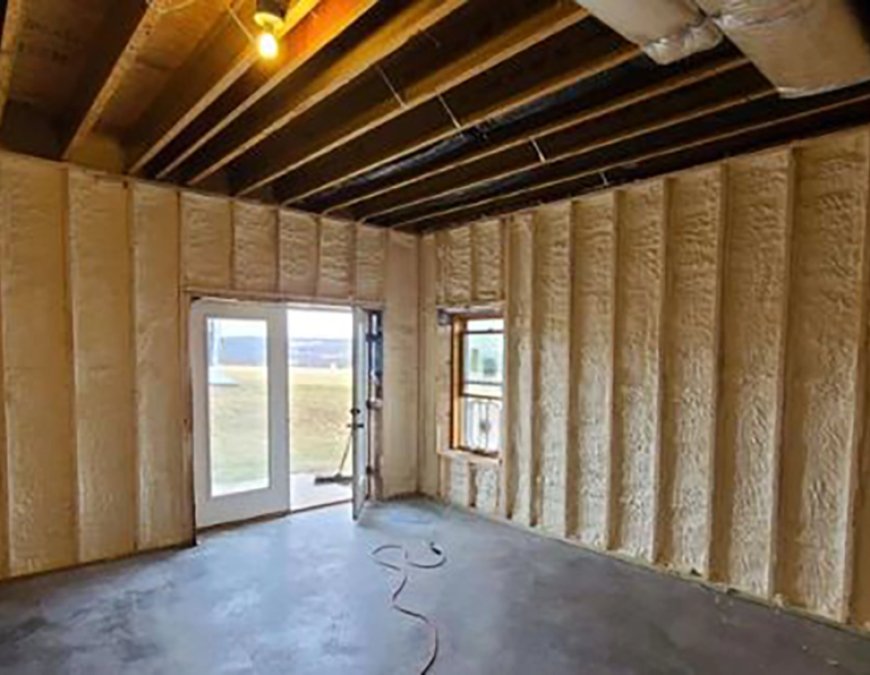The Connection Between Insulation and Noise Control in Crockett, TX Homes
Insulation serves a dual purpose in Crockett, TX homes by simultaneously reducing energy costs and controlling unwanted noise transmission.

Insulation serves a dual purpose in Crockett, TX homes by simultaneously reducing energy costs and controlling unwanted noise transmission. The same materials that prevent heat transfer also absorb sound waves, creating quieter indoor environments while improving thermal efficiency. Proper insulation installation can reduce noise transmission by 40-60% depending on the material type and installation method.
Modern insulation materials function as acoustic barriers by disrupting sound wave patterns through absorption and deflection. D&D Insulation LLC has observed that homes with comprehensive insulation systems experience significantly lower noise levels from external sources like traffic, construction, and weather events common in East Texas. The key lies in understanding how different insulation types interact with various frequencies and sound transmission paths.
Understanding Sound Transmission and Insulation Performance
Sound travels through homes via two primary pathways: airborne transmission and structure-borne vibration. Airborne sounds include voices, television audio, and outdoor noise that moves through air gaps and porous materials. Structure-borne sounds travel through solid building components like walls, floors, and ceilings, often manifesting as footsteps, door slams, or mechanical vibrations.
According to the Acoustic Society of America, residential noise complaints have increased by 23% since 2020, making sound control increasingly important for homeowner satisfaction. Effective insulation addresses both transmission types by filling air gaps and providing mass that dampens vibrations.
The National Institute of Standards and Technology reports that proper insulation can achieve Sound Transmission Class (STC) ratings between 45-65, with higher ratings indicating better noise reduction performance. Crockett's proximity to US Highway 287 and industrial activities makes sound control particularly relevant for local homeowners.
Insulation Material Comparison for Noise Control
|
Material Type |
STC Rating |
Noise Reduction (dB) |
Best Applications |
Installation Method |
|
Spray Foam (Closed Cell) |
50-55 |
15-20 |
Exterior walls, basements |
Professional spray application |
|
Spray Foam (Open Cell) |
45-50 |
12-18 |
Interior walls, attics |
Professional spray application |
|
Fiberglass Batt |
40-45 |
10-15 |
Standard wall cavities |
DIY or professional |
|
Fiberglass Loose Fill |
35-40 |
8-12 |
Attic spaces, irregular areas |
Blown-in installation |
Technical Specifications for Acoustic Performance
|
Performance Metric |
Closed Cell Foam |
Open Cell Foam |
Fiberglass Batt |
Loose Fill |
|
Density (lbs/cu ft) |
2.0-2.5 |
0.4-0.5 |
0.6-1.0 |
0.6-0.8 |
|
Sound Absorption Coefficient |
0.65-0.85 |
0.70-0.90 |
0.50-0.70 |
0.45-0.65 |
|
Frequency Range (Hz) |
250-4000 |
125-4000 |
500-2000 |
500-2000 |
|
Thermal Resistance (R-value) |
6.0-7.0 per inch |
3.5-4.0 per inch |
3.1-3.8 per inch |
2.2-4.3 per inch |
Climate-Specific Considerations for East Texas
Crockett's humid subtropical climate creates unique challenges for insulation performance. High humidity levels can affect material density and acoustic properties over time. Summer temperatures reaching 95°F and winter lows around 35°F create thermal cycling that impacts insulation integrity.
Bonus Tip: Install vapor barriers with acoustic insulation in Crockett homes to prevent moisture-related degradation that can reduce sound dampening effectiveness by up to 30% over five years.
The region's clay soil composition contributes to structural settling, which can create gaps in insulation systems. Regular inspection ensures continued acoustic performance as buildings naturally shift. Spring storms and occasional severe weather events also test insulation systems' ability to maintain both thermal and acoustic barriers.
Professional Installation Impact on Performance
Installation quality directly affects acoustic performance regardless of material choice. Gaps as small as 1% of wall surface area can reduce sound barrier effectiveness by 50%. Professional installation ensures proper sealing around electrical outlets, pipe penetrations, and structural elements where sound commonly leaks through.
Research from the Building Performance Institute shows that professionally installed insulation systems maintain consistent acoustic ratings 15-20% longer than DIY installations. Proper compression ratios, continuous coverage, and appropriate material selection require experience-based knowledge of how different products perform in specific applications.
Things to Consider Before Making a Decision
Evaluate your home's primary noise sources before selecting insulation materials. External noise from traffic requires different solutions than internal sound transmission between rooms. Consider the building's construction type, as frame construction responds differently to acoustic treatments than masonry or steel frame buildings.
Budget allocation should account for both material costs and professional installation when acoustic performance is the primary goal. Higher-performance materials often provide better long-term value through superior durability and consistent performance over time.
Existing insulation conditions affect retrofit options. Homes with inadequate thermal insulation may benefit from comprehensive upgrades that address both energy efficiency and noise control simultaneously. Timing renovations to address multiple building performance issues creates cost efficiencies.
Building code requirements in Texas specify minimum R-values but don't mandate acoustic performance standards for residential construction. Homeowners must specify acoustic goals explicitly when working with experts to ensure appropriate material selection and installation techniques.
Comprehensive Insulation Services for Enhanced Comfort
Open Cell Insulation
Open cell spray foam provides excellent sound absorption properties while maintaining breathability for moisture management. The material expands to fill irregular spaces completely, eliminating sound transmission paths through gaps and cracks. Ideal for interior wall applications where sound control between rooms is the primary concern.
Closed Cell Insulation
Closed cell spray foam offers superior structural strength and sound barrier performance for exterior applications. The material's density provides excellent airborne sound blocking while adding structural rigidity to wall assemblies. Best suited for basements, crawl spaces, and exterior walls facing high-noise environments.
Fiberglass Batt Insulation
Traditional fiberglass batts remain cost-effective for standard wall cavity insulation with moderate acoustic requirements. Pre-cut dimensions fit standard framing spacing, making installation straightforward for both professionals and experienced DIY homeowners. Effective for general noise reduction in bedrooms and living areas.
Fiberglass Loose Fill Insulation
Blown-in fiberglass fills irregular spaces and provides consistent coverage in attic applications. The material settles uniformly around obstacles like wiring and ductwork, maintaining thermal and acoustic barriers without gaps. Particularly effective for reducing overhead noise transmission through ceiling assemblies.
Paint Over Spray Foam
Specialized coating systems protect spray foam insulation from UV degradation while maintaining acoustic properties. These protective finishes prevent material deterioration that can compromise sound absorption over time. Essential for exposed foam applications in basements or utility areas.
Spray Foam Roof Insulation
Roofing applications of spray foam create continuous thermal and acoustic barriers that reduce both energy costs and noise from rain, hail, and wind. The seamless application eliminates thermal bridging while providing superior sound dampening compared to traditional roofing insulation methods.
Common Questions About Insulation and Noise Control
How much noise reduction can I expect from upgrading insulation? Properly installed insulation typically reduces noise transmission by 40-60% compared to uninsulated walls. The exact reduction depends on material type, installation quality, and existing construction details.
Will insulation help with neighbor noise in attached homes? Insulation significantly reduces airborne sound transmission through shared walls. However, structure-borne vibrations may require additional treatments like resilient channels or decoupling systems for maximum effectiveness.
Can I add acoustic insulation to existing walls without major renovation? Blown-in insulation can be added to existing wall cavities through small access holes, improving both thermal and acoustic performance without extensive demolition work.
Does climate affect insulation's sound-dampening properties? Humidity and temperature fluctuations can impact material density and performance over time. Proper vapor control and material selection ensure consistent acoustic performance in East Texas conditions.
Frequently Asked Questions
Q: How long does acoustic insulation maintain its sound-dampening properties? A: Quality insulation materials maintain acoustic performance for 15-25 years with proper installation and moisture control. Spray foam systems typically outlast fiberglass products in humid climates due to superior moisture resistance.
Q: Can insulation reduce low-frequency noise like traffic rumble? A: Dense materials like closed-cell spray foam effectively reduce low-frequency sounds, while lighter materials primarily address mid to high-frequency noise. Combining different materials often provides the best overall acoustic performance.
Q: What's the difference between sound absorption and sound blocking? A: Sound absorption reduces echo and reverberation within rooms, while sound blocking prevents noise transmission between spaces. Most insulation materials provide both benefits to varying degrees based on density and installation method.
Q: Do I need special permits for acoustic insulation upgrades? A: Standard insulation upgrades typically don't require permits in Texas, but structural modifications or electrical work associated with installation may need approval. Check with local building officials before beginning work.
Q: How do I maintain insulation's acoustic performance over time? A: Regular inspection for gaps, settling, or moisture damage ensures continued effectiveness. Address air leaks promptly and maintain proper ventilation to prevent humidity-related degradation of insulation materials.
Ready to Achieve Better Sound Control and Energy Efficiency
Professional insulation installation provides the expertise needed to maximize both thermal and acoustic performance in your Crockett home. Proper material selection and installation techniques ensure long-term effectiveness and value from your investment.
Transform your home's comfort level with comprehensive insulation solutions that address both energy efficiency and noise control simultaneously. Contact D&D Insulation LLC at (903) 389-5705 or office@dndinsulation.com to discuss your specific acoustic and thermal comfort needs.
Reviewer
Henry Turner has 9 years of experience in spray foam insulation. He reviewed this article and helped shape it into a clear guide for companies working to build trust in their local market.





















































































































































